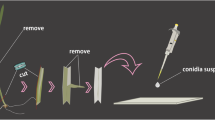Abstract
Talaromyces sp. isolate KNB-422, isolated from a rice seedling, is a biofungicidal agent effective against several seedborne pathogens of rice including Gibberella fujikuroi, which causes Bakanae disease. Because the fungal mode of action (MOA) has not yet been clarified, we used the fluorescent protein markers GFP and RFP to visualize cell–cell interactions between the biocontrol agent and the pathogen G. fujikuroi. In slide culture, the hyphal cell wall of G. fujikuroi collapsed, and fluorescence of its cytoplasm disappeared 3 days after contact with hyphae of Talaromyces sp. On inoculated rice plants, both fungi occupied the same regions of coleoptiles and roots, where the biocontrol effect of Talaromyces sp. must be exerted. Our observations suggest that the MOA of Talaromyces sp. is mycoparasitic.





Similar content being viewed by others
References
Boosalis MG (1956) Effect of soil temperature and green-manure amendment of unsterilized soil on parasitism of Rhizoctonia solani by Penicillium vermiculatum and Trichoderma sp. Phytopathology 46:473–478
Czymmek KJ, Bourett TM, Howard RJ (2005) Fluorescent protein probes in fungi. In: Savidge T, Charalabos P (eds) Methods in microbiology, vol 34, Microbial imaging. Elsevier, London, pp 27–62
de Weert S, Kuiper I, Lagendijk EL, Lamers GEM, Lugtenberg BJJ (2004) Role of chemotaxis toward fusaric acid in colonization of hyphae of Fusarium oxysporum f. sp. radicis-lycopersici by Pseudomonas fluorescens WCS365. Mol Plant Microbe Interact 17:1185–1191
Desjardins AE, Manandhar HK, Platter RD, Manandhar GG, Poling SM, Maragos CM (2000) Fusarium species from Nepalese rice and production of mycotoxins and gibberellic acid by selected species. Appl Environ Microbiol 66:1020–1025
Errampalli D, Leung K, Cassidy MB, Kostrzynska M, Blears M, Lee H, Trevors JT (1999) Applications of the green fluorescent protein as a molecular marker in environmental microorganisms. J Microbiol Methods 35:187–199
Inada N, Sakai A, Kuroiwa H, Kuroiwa T (1998) Three-dimensional analysis of the senescence program in rice (Oryza sativa L.) coleoptiles. Planta 205:153–164
Kumazawa S, Ito A, Saishoji T, Chuman H (2000) Development of new fungicides, ipconazole and metconazole (in Japanese). J Pestic Sci 25:321–331
Lorang JM, Tuori RP, Martinez JP, Sawyer TL, Redman RS, Rollins JA, Wolpert TJ, Johnson KB, Rodriguez RJ, Dickman MB, Ciuffetti LM (2001) Green fluorescent protein is lighting up fungal biology. Appl Environ Microbiol 67:1987–1994
Lu Z, Tombolini R, Woo S, Zeilinger S, Lorito M, Jansson JK (2004) In vivo study of Trichoderma–pathogen–plant interactions, using constitutive and inducible green fluorescent protein reporter systems. Appl Environ Microbiol 70:3073–3081
Madi L, Katan T, Henis Y (1992) Inheritance of antagonistic properties and lytic enzyme activities in sexual crosses of Talaromyces flavus. Ann Appl Biol 121:565–576
Madi L, Katan T, Katan J, Henis Y (1997) Biological control of Sclerotium rolfsii and Verticillium dahliae by Talaromyces flavus is mediated by different mechanisms. Phytopathology 87:1054–1060
Marcello CM, Steindorff AS, da Silva SP, Silva RN, Mendes Bataus LA, Ulhoa CJ (2010) Expression analysis of the exo-β-1, 3-glucanase from the mycoparasitic fungus Trichoderma asperellum. Microbiol Res 165:75–81
McLaren DL, Huang HC, Rimmer SR (1986) Hyperparasitism of Sclerotinia sclerotiorum by Talaromyces flavus. Can J Plant Pathol 8:43–48
Neergaard P (1977) Seed pathology. Macmillan, London
Plautz JD, Day RN, Dailey GM, Welsh SB, Hall JC, Halpain S, Kay SA (1996) Green fluorescent protein and its derivatives as versatile markers for gene expression in living Drosophila melanogaster, plant and mammalian cells. Gene 173:83–87
Shimomura O, Johnson FH, Saiga Y (1962) Extraction, purification and properties of aequorin, a bioluminescent protein from the luminous hydromedusan, Aequorea. J Cell Comp Physiol 59:223–239
Suzuki H, Takahashi S, Fujita Y, Sonoda R (1985) Effect of seed-disinfection by thiram benomyl on blast, brown spot and “Bakanae” disease of rice (in Japanese). Ann Rep Plant Prot North Jpn 36:122–124
Tateishi H, Saishoji T, Suzuki T, Chida T (1998) Antifungal properties of the seed disinfectant ipconazole and its protection against ‘‘Bakanae’’ and other diseases of rice. Ann Phytopathol Soc Jpn 64:443–450
Tateishi H, Sakuma Y, Miyake T (2006) Isolation and screening of antagonistic fungi against rice seedling diseases and their efficacy (Abstract in Japanese). Jpn J Phytopathol 72:265–266
Watanabe S, Kumakura K, Izawa N, Nagayama K, Mitachi T, Kanamori M, Teraoka T, Arie T (2007) Mode of action of Trichoderma asperellum SKT-1, a biocontrol agent against Gibberella fujikuroi. J Pestic Sci 32:222–228
Acknowledgments
We thank Dr. Olen Yoder (Celgene Co., San Diego, CA, USA) for helpful suggestions and discussions when he was a visiting professor at TUAT. This research was partly supported by the grant ‘Development of mitigation and adaptation techniques to global warming in the sectors of agriculture, forestry, and fisheries’ for TA from Ministry of Agriculture Forestry, and Fisheries of Japan.
Author information
Authors and Affiliations
Corresponding author
Electronic supplementary material
Below is the link to the electronic supplementary material.
10327_2011_343_MOESM1_ESM.ppt
Supplemental Figure Structures of plasmids used in this study. a pMK412 carries egfp driven by the translation elongation factor (TEF) promoter from Aureobasidium pullulans and the glucoamylase (gla) terminator from Aspergillus awamori and a hygromycin B phosphotransferase gene (hph) driven by the trifunctional polypeptide (trpC) promoter and terminator from Aspergillus nidulans. b pDsRed2 (Takara Bio) carries dsred2. c pAK2-HYG, constructed from pMK412 and pDsRed2 in this study, carries dsred2 driven by PTEF and Tgla, and the hph cassette. Black arrows on a and b approximate positions of primers used to construct pAK2-HYG (PPT 252 kb)
Rights and permissions
About this article
Cite this article
Kato, A., Miyake, T., Nishigata, K. et al. Use of fluorescent proteins to visualize interactions between the Bakanae disease pathogen Gibberella fujikuroi and the biocontrol agent Talaromyces sp. KNB-422. J Gen Plant Pathol 78, 54–61 (2012). https://doi.org/10.1007/s10327-011-0343-9
Received:
Accepted:
Published:
Issue Date:
DOI: https://doi.org/10.1007/s10327-011-0343-9




